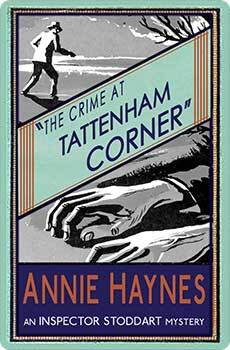The Crime At Tattenham Corner

A review of The Crime at Tattenham Corner by Annie Haynes – 230425
Originally published in 1929 and reissued by Dean Street Press, The Crime at Tattenham Corner is the second in Haynes’ Inspector Stoddart series. The story starts on the eve of the Epsom Derby, the race in which Sir John Burslem’s horse, Peep O’Day, is the bookies’ favourite. The horse does not run to the dismay of many who have put their shirt on the animal as Burslem’s body is found in a ditch near Tattenham Corner, a village and railway station near the racecourse. Under the rules of the race, if the owner is dead, the horse has to scratch.
The second favourite, Perlyon, wins the race and Burslem’s death – he was shot but not at close range – immediately puts suspicion on its owner, Charles Stanyard, who was not only in the area at the time but also was engaged to Burslem’s much younger wife, Sybil. Needless to say, the plot is a lot more complicated than that. We are treated to lashings of spiritualism, thanks to the ludicrously preposterous Mrs Jimmy Burslem, wife of the explorer, Burslem’s brother James, who is believed to be in Tibet, a disappearing head valet, Ellerby, and a number of physical clues, a handbag, a cigarette case, and a revolver found near the scene that turns out not to have been used in the murder.
Just before his death, Burslem, a successful financier, had time to make an unexpected return to his home and changed his will, handing over all his wealth and assets to his wife, Sophie, and cutting his daughter, Pamela, out completely. It is not long after his death that Peep O’Day is surprisingly sold to Argentinia and Sophie is in cahoots with an Argentinian secretary who is assisting her with administering Burslem’s former affairs.
There are a number of suspects, each of whom has their moment under the spotlight and Haynes’ best moments in this rather sprawling novel that she seems at times to barely control is to shift the reader’s suspicions from one to the other. For me the highlight of the book is the working relationship between Stoddart and his assistant, Alfred Harbord, who are amiable companions and work well, although they have slightly differing views as to what really happened to Harbord. Stoddart adopts a slightly patronising attitude to his junior, allowing him the room to show initiative and develop his own theories only to gently puncture the theory by pointing out some clue or inference that does not fit into the explanation.
Stoddart, though, is no inspired detective whose brilliant intellect sees through the cunning plans of the murderer. He too struggles to fit all the facts, clues, and inferences into a coherent case and when he steels his nerve to make an arrest in an amusing episode that involves him assuming a disguise to gain entry to the suspect’s suite – disguise and misidentification is a running theme through the book – it is clear to the reader that the case for the prosecution has so many holes in it that a competent defence lawyer would drive a coach and horses, never mind a thoroughbred, through it.
Nevertheless, to court it goes and the trial is a society sensation. That Stoddart has backed the wrong horse is revealed by a death bed confession, the true culprit having been involved in what turns out to be a fatal road accident but still, like all good Catholics should, has time to unburden their soul before meeting their maker. I always feel that these death bed confessions are a bit of a cop out on the part of the writer, and everything is wrapped up a little too tidily with more than an unhealthy dollop of “and they lived happily ever after” for my taste.
The book has more than a touch of the melodramatic potboiler about it, but it is entertaining and kept me guessing until the end.



